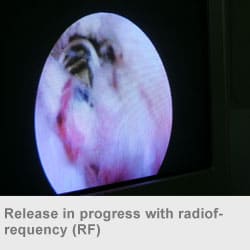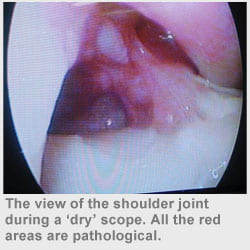Frozen shoulder, also called adhesive capsulitis is a problem characterized by a stiff shoulder, with global restriction of movement. There is a strong co relation with diabetes. It is one of the commonest problems that I see patients for in my practice. Although its exact cause is yet unknown, it is characterized by scarring and thickening of the capsule that encircles the joint leading to a painful, stiff joint.
Classically, it is said to undergo 3 phases:
The painful phase, the freezing phase and the thawing phase.fs2
The painful phase:
As the name suggests, pain predominates in this phase. Occasionally it can be severe, and sleep disturbances are not uncommon! Various pain control measures can be taken at this stage including physical therapy, NSAIDS or occasionally opioids. I recommend an intra articular injection of a corticosteroid in this stage and it helps in pain control. All surgical measures in this phase are best avoided as pain can be aggravated. This can last for several months!
The freezing phase:
By far this is the most common stage of presentation. The patient will typically give a history of being in pain for a period of 3 to 6 months or even longer, occasionally even up to 9 months, but now stiffness predominates. Pain accompanies when the shoulder is moved beyond its available range of motion
The thawing phase:
Typically, this is the final stage in which the shoulder returns to the pre affliction status It is said that it can take up to 18 months for this to happen. In my experience, contrary to popular traditional belief; most people are left with some residual deficit and pain.
Treatment:
the goals of treatment are pain relief and early restoration of function. Pain control measures taken include physical therapy, NSAIDS or occasionally opioids(narcotic) and steroids taken oral or injected into the joint.
- Fracture Around The Shoulder
- Shoulder Arthroscopy
- Shoulder Impingement
- Rotator Cuff Tear
- frozen Shoulder
- Shoulder dislocation
- Shoulder Joint Replacement
- Biceps Tendinitis
- Reverse Shoulder Replacement Surgery
- Calcific Tendinitis
- Elbow Replacement
- Elbow Arthroscopy
- Tennis Elbow
- Wrist Fractures
- Wrist Scaphoid Fractures
- Wrist Arthroscopy
- Rheumatoid Wrist
- Carpal Injuries
- Wrist Scaphoid Nonunion
Services
Manipulation under Anaesthesia:
commonly called an MUA, it is a procedure carried on an outpatient basis, where the patient is asleep under a general anesthetic, and the stiff shoulder is taken through specific maneuvers to ‘release’ the thick adherent capsule manually. Under cover of strong analgesia patients are then subjected to intensive physiotherapy under supervision. Majorities recover within 4 to 6 weeks, but may take longer. “Hand behind the back movement” is the last to come. It is not unusual to have a mild restriction in this motion for life.


Arthroscopic capsular release:
This is an advanced technique in which the shoulder is approached through a keyhol a camera is introduced in the joint and under vision, the contracted and thickened capsule is released with specific hand instruments and radio frequency (RF) heat probes. The main indication for this in my practice are patients who have failed to improve after an MUA, where MUA is contraindicated or where I clinically suspect other concomitant pathology which can be dealt with while performing the arthroscopy. Results and recovery After surgery, physical therapy is necessary to maintain the motion that was achieved with surgery. Recovery times vary, from 6 weeks to three months. Although it is a slow process, your commitment to therapy is the most important factor in returning to all the activities you enjoy.
Long-term outcomes after surgery are generally good, with most patients having reduced or no pain and greatly improved range of motion. In some cases, however, even after several years, the motion does not return completely and a small amount of stiffness remains.
Although uncommon, Frozen Shoulder can recur, especially if a contributing factor like diabetes is still present.
